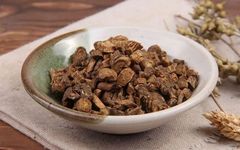
The formulas for treating mixed cold and heat conditions as recorded in the “Shang Han Lun” include Chai Hu Gui Zhi Gan Jiang Tang (Bupleurum and Cinnamon Decoction with Dried Ginger), Zhi Zi Gan Jiang Tang (Gardenia and Dried Ginger Decoction), Ban Xia Xie Xin Tang (Pinellia Decoction to Drain the Heart), Fu Zi Xie Xin Tang (Aconite Decoction to Drain the Heart), Huang Lian Tang (Coptis Decoction), Wu Mei Wan (Mume Pill), Ma Huang Sheng Ma Tang (Ephedra and Cimicifuga Decoction), and Gan Jiang Huang Qin Huang Lian Ren Shen Tang (Dried Ginger, Scutellaria, Coptis, and Ginseng Decoction), totaling eight formulas.
Chai Hu Gui Zhi Gan Jiang Tang has been discussed previously, while Zhi Zi Gan Jiang Tang will be briefly mentioned. Sheng Jiang Xie Xin Tang (Fresh Ginger Decoction to Drain the Heart) and Gan Cao Xie Xin Tang (Licorice Decoction to Drain the Heart) can be represented by Ban Xia Xie Xin Tang. Below is a brief description of each formula.
Ban Xia Xie Xin TangBan Xia Xie Xin Tang is a formula that combines cold and hot herbs. It is a representative formula for harmonizing the cold and heat evils affecting the spleen and stomach. Sheng Jiang Xie Xin Tang and Gan Cao Xie Xin Tang are modifications based on this formula. It is used to treat a condition characterized by disharmony of spleen and stomach qi, with fullness and distension below the heart accompanied by phlegm and fluid.Due to the presence of phlegm and fluid, it also includes symptoms of vomiting. Clinical observations indicate that this condition may present with fullness below the heart, vomiting, borborygmus, diarrhea, or irregular bowel movements.
This condition arises from the disharmony of yin and yang in the spleen and stomach, with disordered ascending and descending qi, leading to obstruction in the middle jiao, and the generation of phlegm and fluid due to mixed cold and heat. Therefore, Ban Xia Xie Xin Tang is primarily used to bitterly descend, disperse, harmonize the stomach, and clear phlegm.
Ban Xia Xie Xin Tang consists of Ban Xia (Pinellia), Huang Qin (Scutellaria), Huang Lian (Coptis), Ren Shen (Ginseng), Zhi Gan Cao (Honey-fried Licorice), and Da Zao (Jujube). This condition is characterized by poor ascending and descending of qi, obstruction in the middle jiao, and heat generated due to the stomach qi not descending, thus the bitter cold herbs are used to descend, while the coldness of the spleen qi leads to borborygmus and diarrhea.Therefore, the warm and spicy properties of Gan Jiang (Dried Ginger) are used to warm it, and since phlegm and fluid disturb the stomach, causing vomiting, Ban Xia is used to descend and harmonize the stomach to stop vomiting.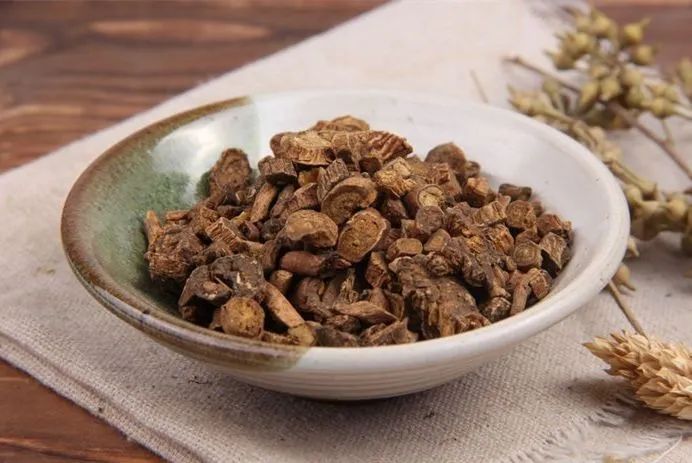 With weak spleen and stomach qi unable to regulate the ascending and descending, Ren Shen, Gan Cao, and Da Zao are used to tonify it. This formula clears the upper and warms the lower, using both bitter and spicy herbs, and employs both cold and heat to harmonize the spleen and stomach, making it the main formula for treating fullness below the heart.【Note】The area below the heart is a half-exterior, half-interior location (below the chest and above the abdomen), thus when there is a disease, it is appropriate to use Xie Xin Tang to harmonize. Xiao Chai Hu Tang treats the liver and gallbladder, while Xie Xin Tang treats the spleen and stomach.Both conditions share the characteristic of poor ascending and descending qi, and both are caused by the disharmony of yin and yang. If not treated with harmonization but with other methods, the disease cannot be cured.Especially since the “below the heart” area is the key pathway for qi’s ascent and descent, if the communication of yin and yang is obstructed, it leads to fullness. Fullness is a blockage, where qi stagnates and does not flow, neither blood nor water, and is not a solid mass, thus pressing on it feels moist, but it is merely qi fullness.Zhang, male, 36 years old. He has a habit of drinking alcohol and presents with fullness below the heart, occasional vomiting, and unformed stools, three to four times a day, with various treatments yielding no effect. His pulse is wiry and slippery, and his tongue coating is white.
With weak spleen and stomach qi unable to regulate the ascending and descending, Ren Shen, Gan Cao, and Da Zao are used to tonify it. This formula clears the upper and warms the lower, using both bitter and spicy herbs, and employs both cold and heat to harmonize the spleen and stomach, making it the main formula for treating fullness below the heart.【Note】The area below the heart is a half-exterior, half-interior location (below the chest and above the abdomen), thus when there is a disease, it is appropriate to use Xie Xin Tang to harmonize. Xiao Chai Hu Tang treats the liver and gallbladder, while Xie Xin Tang treats the spleen and stomach.Both conditions share the characteristic of poor ascending and descending qi, and both are caused by the disharmony of yin and yang. If not treated with harmonization but with other methods, the disease cannot be cured.Especially since the “below the heart” area is the key pathway for qi’s ascent and descent, if the communication of yin and yang is obstructed, it leads to fullness. Fullness is a blockage, where qi stagnates and does not flow, neither blood nor water, and is not a solid mass, thus pressing on it feels moist, but it is merely qi fullness.Zhang, male, 36 years old. He has a habit of drinking alcohol and presents with fullness below the heart, occasional vomiting, and unformed stools, three to four times a day, with various treatments yielding no effect. His pulse is wiry and slippery, and his tongue coating is white.
Diagnosis: The condition is due to alcohol harming the spleen and stomach, with disordered ascending and descending, and phlegm generated from within. Phlegm and fluid cause the stomach qi to rebel, leading to vomiting, and spleen deficiency with cold qi results in unformed stools, with disharmony of middle qi, leading to fullness below the heart.
Prescription: Ban Xia 12g, Gan Jiang 6g, Huang Qin 6g, Huang Lian 6g, Dang Shen 9g, Zhi Gan Cao 9g, Da Zao 7 pieces.
After taking one dose, he had a large amount of white, sticky stools, and vomiting decreased by seventy percent; after another dose, both fullness and vomiting decreased, and after taking two more doses, he was cured.
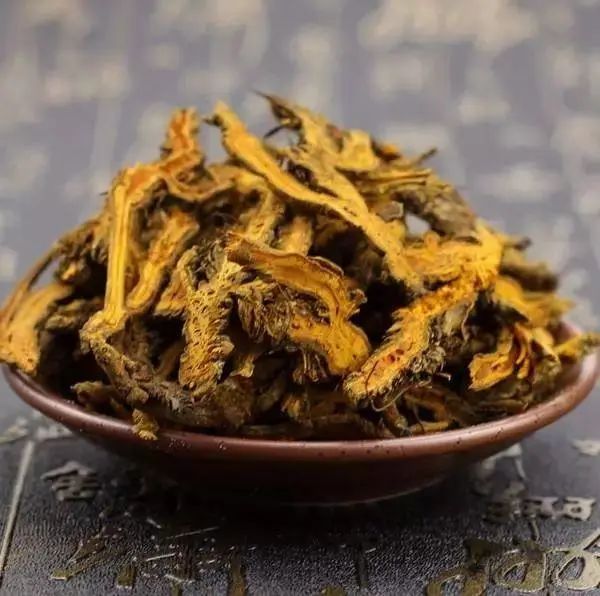
Fu Zi Xie Xin TangFu Zi Xie Xin Tang is used to treat heat fullness below the heart, with yang deficiency unable to protect the exterior, and symptoms of “aversion to cold and sweating”. Generally, fever leads to easy sweating, while aversion to cold does not easily lead to sweating. However, when aversion to cold occurs simultaneously with sweating, it reflects a deficiency of defensive yang and a failure to warm.Defensive yang refers to the yang qi that protects the exterior, originating from the lower jiao, transformed from the kidney’s yang qi, reaching the body surface to “warm the flesh, fill the skin, nourish the pores, and control opening and closing”.Now, with yang deficiency in the lower jiao, the generation of defensive yang is insufficient, losing its function of warming and protecting the muscle surface, thus presenting with aversion to cold and sweating, hence termed as a syndrome of upper heat and lower cold. The treatment uses Fu Zi Xie Xin Tang to clear heat fullness and warm the yang qi.Fu Zi Xie Xin Tang consists of Da Huang (Rhubarb), Huang Lian (Coptis), Huang Qin (Scutellaria), and Pao Fu Zi (Processed Aconite). The ingredients are soaked in boiling water to treat the heat fullness in the qi level, while Fu Zi is boiled separately to extract its strong flavor and power to specifically tonify the deficiency of kidney yang.Although this formula uses both cold and hot herbs, the three yellow herbs are soaked in water, while Fu Zi is boiled separately, thus the main focus is on tonifying yang, with clearing heat as a secondary action.A student from Ningxiang had an external pathogen for several months, repeatedly treated without improvement. Upon examination, he reported fullness in the chest, heat in the upper body with sweating, and aversion to wind below the waist, during the summer in June, while being wrapped in blankets. Reviewing the previous prescriptions, they were all common cooling and purging herbs that did not address the root cause. His tongue coating was pale yellow, and his pulse was wiry.After taking Fu Zi Xie Xin Tang, he returned for a follow-up two days later, stating that the symptoms had significantly improved. He was discharged after a successful recovery. (Cited from “Dun Yuan: Medical Cases”)
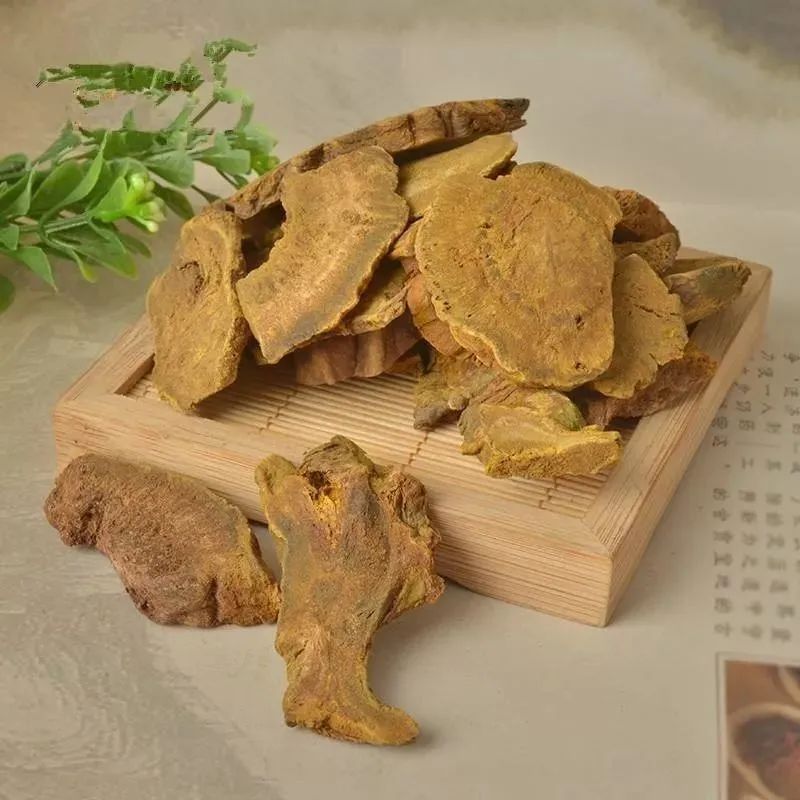
Huang Lian TangThe syndrome of Huang Lian Tang belongs to the pathological changes of “Shang Han with heat in the chest and evil qi in the stomach”. Heat in the chest leads to vomiting, while evil qi in the stomach causes abdominal pain or diarrhea. The treatment with Huang Lian Tang employs both cold and warm herbs, with sweet and bitter flavors to regulate the yin and yang of the upper and lower, harmonizing the evil.Huang Lian Tang consists of Huang Lian (Coptis), Zhi Gan Cao (Honey-fried Licorice), Gan Jiang (Dried Ginger), Gui Zhi (Cinnamon), Ren Shen (Ginseng), Ban Xia (Pinellia), and Da Zao (Jujube). The formula uses Huang Lian to clear heat in the chest, Gan Jiang to warm the cold in the spleen and stomach, Gui Zhi to promote the upward flow of yang qi, Ban Xia to descend and stop vomiting, and Ren Shen, Gan Cao, and Da Zao to nourish the stomach and calm the center, facilitating the regulation of the upper and lower, and harmonizing cold and heat yin and yang.A patient from Xuzhou presented with vomiting and diarrhea, with three to four bowel movements a day, urgency and heaviness in the abdomen, and red and white mucus. After a year of treatment at various places without improvement, he came to Beijing due to work and was introduced to me for diagnosis. His pulse was wiry and slippery, and he had weak pressure, with a red tongue and white coating.Diagnosis: This is a mixed cold and heat evil, affecting the spleen and stomach. If only one aspect is treated, either cold is used to treat heat or heat to treat cold, it will not be effective. When cold and heat are both present, the method of Huang Lian Tang should be followed.Prescription: Huang Lian 9g, Gan Jiang 9g, Gui Zhi 9g, Ban Xia 9g, Ren Shen 6g, Zhi Gan Cao 6g, Da Zao 7 pieces.After taking a total of six doses, the year-long illness was cured.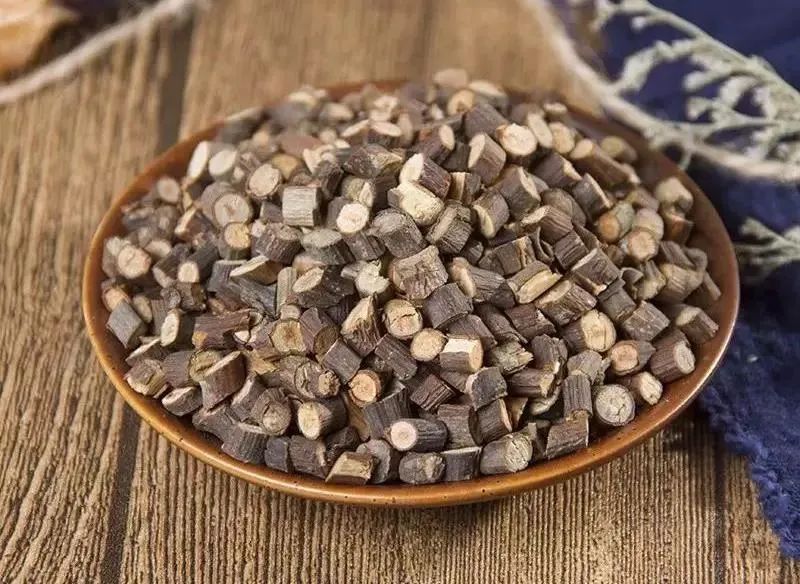 Wu Mei WanWu Mei Wan is the main formula for treating the Jue Yin disease. When the disease reaches Jue Yin, there is a mutual retreat of yin and yang, characterized by mixed cold and heat symptoms such as “thirst, qi rising to the heart, heat in the heart, and hunger without desire to eat”.Due to the mixed cold and heat, with upper heat and lower cold, it may present as vomiting of roundworms and coldness in the hands and feet, termed “worm cold” syndrome, all of which can be treated with Wu Mei Wan.Wu Mei Wan consists of Wu Mei (Mume), Xi Xin (Asarum), Gan Jiang (Dried Ginger), Huang Lian (Coptis), Fu Zi (Aconite), Dang Gui (Angelica), Shu Jiao (Sichuan Pepper), Gui Zhi (Cinnamon), Ren Shen (Ginseng), and Huang Bai (Phellodendron). This formula is the main treatment for the mixed cold and heat of Jue Yin and the “worm cold” syndrome.The formula uses Wu Mei soaked in vinegar to nourish yin and harmonize yang, with effects of harmonizing the liver, calming the stomach, stopping thirst, and calming roundworms. Fu Zi, Gan Jiang, and Gui Zhi warm the channels and support yang to overcome cold.Chuan Jiao and Xi Xin are spicy and warm, capable of promoting yang and breaking yin, and can kill roundworms. Huang Lian and Huang Bai are bitter and cold to clear heat and vexation, and also subdue roundworms and treat vomiting. Ren Shen tonifies qi to strengthen the spleen, while Dang Gui nourishes blood to support the liver.The combination of these herbs eliminates cold and heat evils, harmonizes yin and yang, softens the liver, warms the lungs, and calms roundworms, which is the purpose of this formula.Although the formula uses both cold and hot herbs, it leans more towards warming herbs, and with Wu Mei’s sour and astringent properties, it can treat prolonged diarrhea due to mixed cold and heat.Rice and honey are used as auxiliary materials to make pills, which not only nourish the stomach qi deficiency but also serve as bait to attract roundworms.
Wu Mei WanWu Mei Wan is the main formula for treating the Jue Yin disease. When the disease reaches Jue Yin, there is a mutual retreat of yin and yang, characterized by mixed cold and heat symptoms such as “thirst, qi rising to the heart, heat in the heart, and hunger without desire to eat”.Due to the mixed cold and heat, with upper heat and lower cold, it may present as vomiting of roundworms and coldness in the hands and feet, termed “worm cold” syndrome, all of which can be treated with Wu Mei Wan.Wu Mei Wan consists of Wu Mei (Mume), Xi Xin (Asarum), Gan Jiang (Dried Ginger), Huang Lian (Coptis), Fu Zi (Aconite), Dang Gui (Angelica), Shu Jiao (Sichuan Pepper), Gui Zhi (Cinnamon), Ren Shen (Ginseng), and Huang Bai (Phellodendron). This formula is the main treatment for the mixed cold and heat of Jue Yin and the “worm cold” syndrome.The formula uses Wu Mei soaked in vinegar to nourish yin and harmonize yang, with effects of harmonizing the liver, calming the stomach, stopping thirst, and calming roundworms. Fu Zi, Gan Jiang, and Gui Zhi warm the channels and support yang to overcome cold.Chuan Jiao and Xi Xin are spicy and warm, capable of promoting yang and breaking yin, and can kill roundworms. Huang Lian and Huang Bai are bitter and cold to clear heat and vexation, and also subdue roundworms and treat vomiting. Ren Shen tonifies qi to strengthen the spleen, while Dang Gui nourishes blood to support the liver.The combination of these herbs eliminates cold and heat evils, harmonizes yin and yang, softens the liver, warms the lungs, and calms roundworms, which is the purpose of this formula.Although the formula uses both cold and hot herbs, it leans more towards warming herbs, and with Wu Mei’s sour and astringent properties, it can treat prolonged diarrhea due to mixed cold and heat.Rice and honey are used as auxiliary materials to make pills, which not only nourish the stomach qi deficiency but also serve as bait to attract roundworms.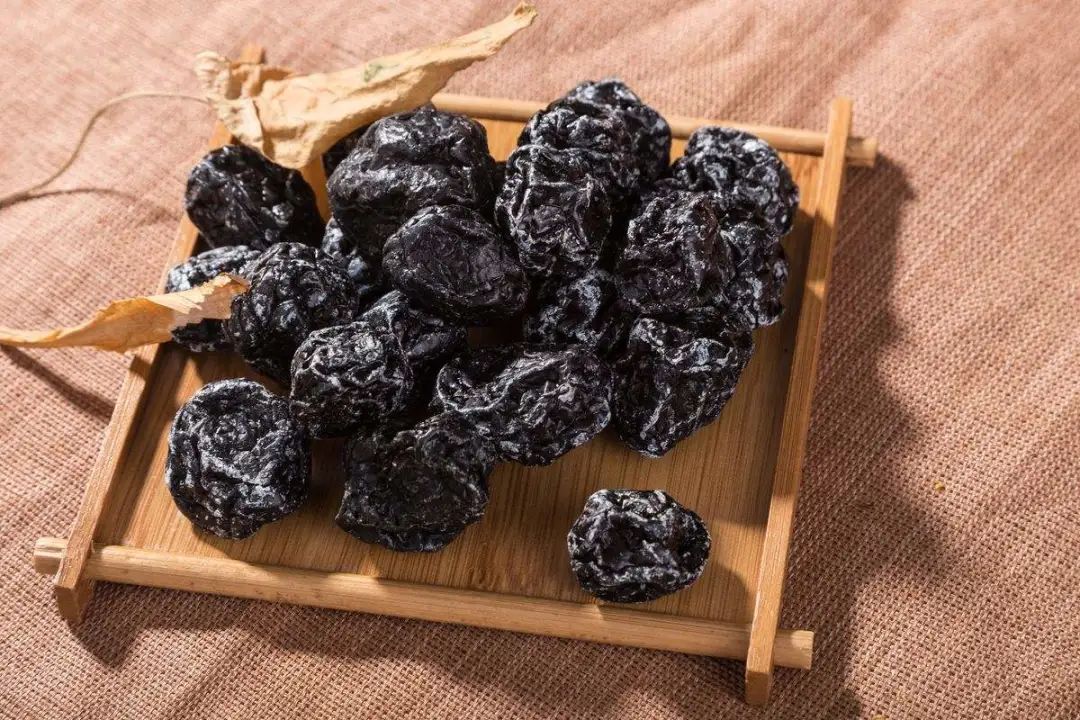 A female patient from Shangzhai, Gansu, aged 36, suddenly experienced paroxysmal severe pain in the upper right abdomen, cold limbs, profuse sweating, and vomiting. She had a history of roundworms.Examination revealed “worm spots” on her face, a wiry and strong pulse, and a crimson tongue with brown coating. Diagnosis was made as “worm cold” syndrome of Jue Yin disease. The prescription was modified from Wu Mei Wan to a decoction, taken in three doses. After two doses, the pain ceased and she felt at ease.However, due to severe bitterness in her mouth, she still experienced vomiting and reported that she had not had a bowel movement for several days. The prescription was changed to Da Chai Hu Tang, and after taking one dose, she had multiple bowel movements and expelled several roundworms, leading to her recovery.Ma Huang Sheng Ma TangMa Huang Sheng Ma Tang treats exterior evils trapped internally, with qi stagnation, upper heat and lower cold, and disharmony of yin and yang. Due to the internal entrapment of yang evils, the originally floating and rapid pulse changes to a sinking and slow pulse.When palpating the lower pulse, it does not reach the depth, indicating that qi is obstructed, and the pulse pathway is not smooth.When qi is obstructed, the yin and yang qi do not connect smoothly, leading to coldness in the hands and feet. If the internal entrapment of yang evils affects the upper, it leads to upper heat and symptoms such as sore throat and vomiting of pus and blood. Yang is trapped above and cannot govern below, leading to continuous diarrhea.This syndrome involves both yin and yang being affected, and the distinctions between deficiency and excess, cold and heat are also blurred, making it a difficult condition to treat.However, Zhang Zhongjing’s Ma Huang Sheng Ma Tang treats both cold and heat, expelling the trapped yang evil externally while nourishing the yin of the lungs and stomach, clearing the upper while warming the lower, ensuring that yin and yang harmonize for recovery.Ma Huang Sheng Ma Tang consists of Ma Huang (Ephedra), Sheng Ma (Cimicifuga), Dang Gui (Angelica), Zhi Mu (Anemarrhena), Huang Qin (Scutellaria), Wei Rui (Ophiopogon), Shao Yao (Peony), Tian Dong (Asparagus), Gui Zhi (Cinnamon), Fu Ling (Poria), Zhi Gan Cao (Honey-fried Licorice), Shi Gao (Gypsum), Bai Zhu (Atractylodes), and Gan Jiang (Dried Ginger).The formula uses a larger dosage of Ma Huang and Sheng Ma to disperse the trapped yang evil, while Huang Qin and Shi Gao clear the evil heat from the lungs and stomach. Gui Zhi and Gan Jiang warm the yang and dispel cold, while Dang Gui and Shao Yao nourish blood to harmonize yin.Zhi Mu, Tian Dong, and Wei Rui nourish yin and lower fire to harmonize yang; Gan Cao, Fu Ling, and Bai Zhu not only strengthen the spleen and benefit qi to stop diarrhea but also calm the stomach and harmonize the center to facilitate the connection of the upper and lower.This formula combines tonifying and purging herbs to work together without conflict. Although it contains up to fourteen ingredients, it is not chaotic, serving a precise purpose in treating mixed cold and heat conditions.
A female patient from Shangzhai, Gansu, aged 36, suddenly experienced paroxysmal severe pain in the upper right abdomen, cold limbs, profuse sweating, and vomiting. She had a history of roundworms.Examination revealed “worm spots” on her face, a wiry and strong pulse, and a crimson tongue with brown coating. Diagnosis was made as “worm cold” syndrome of Jue Yin disease. The prescription was modified from Wu Mei Wan to a decoction, taken in three doses. After two doses, the pain ceased and she felt at ease.However, due to severe bitterness in her mouth, she still experienced vomiting and reported that she had not had a bowel movement for several days. The prescription was changed to Da Chai Hu Tang, and after taking one dose, she had multiple bowel movements and expelled several roundworms, leading to her recovery.Ma Huang Sheng Ma TangMa Huang Sheng Ma Tang treats exterior evils trapped internally, with qi stagnation, upper heat and lower cold, and disharmony of yin and yang. Due to the internal entrapment of yang evils, the originally floating and rapid pulse changes to a sinking and slow pulse.When palpating the lower pulse, it does not reach the depth, indicating that qi is obstructed, and the pulse pathway is not smooth.When qi is obstructed, the yin and yang qi do not connect smoothly, leading to coldness in the hands and feet. If the internal entrapment of yang evils affects the upper, it leads to upper heat and symptoms such as sore throat and vomiting of pus and blood. Yang is trapped above and cannot govern below, leading to continuous diarrhea.This syndrome involves both yin and yang being affected, and the distinctions between deficiency and excess, cold and heat are also blurred, making it a difficult condition to treat.However, Zhang Zhongjing’s Ma Huang Sheng Ma Tang treats both cold and heat, expelling the trapped yang evil externally while nourishing the yin of the lungs and stomach, clearing the upper while warming the lower, ensuring that yin and yang harmonize for recovery.Ma Huang Sheng Ma Tang consists of Ma Huang (Ephedra), Sheng Ma (Cimicifuga), Dang Gui (Angelica), Zhi Mu (Anemarrhena), Huang Qin (Scutellaria), Wei Rui (Ophiopogon), Shao Yao (Peony), Tian Dong (Asparagus), Gui Zhi (Cinnamon), Fu Ling (Poria), Zhi Gan Cao (Honey-fried Licorice), Shi Gao (Gypsum), Bai Zhu (Atractylodes), and Gan Jiang (Dried Ginger).The formula uses a larger dosage of Ma Huang and Sheng Ma to disperse the trapped yang evil, while Huang Qin and Shi Gao clear the evil heat from the lungs and stomach. Gui Zhi and Gan Jiang warm the yang and dispel cold, while Dang Gui and Shao Yao nourish blood to harmonize yin.Zhi Mu, Tian Dong, and Wei Rui nourish yin and lower fire to harmonize yang; Gan Cao, Fu Ling, and Bai Zhu not only strengthen the spleen and benefit qi to stop diarrhea but also calm the stomach and harmonize the center to facilitate the connection of the upper and lower.This formula combines tonifying and purging herbs to work together without conflict. Although it contains up to fourteen ingredients, it is not chaotic, serving a precise purpose in treating mixed cold and heat conditions. Li Mengru’s child had throat issues twice and diarrhea once, all treated successfully. Now, he suffers from a cold and heat illness that has persisted for over ten days, and I was invited to diagnose.Upon pulse examination, he had already had diarrhea twice, with headaches, abdominal pain, and joint pain, and his throat was completely white and rotten, with purulent phlegm mixed with blood. The six pulses were floating, and the middle two were not palpable, while pressing was slightly slow, making it impossible to determine the exact number. He was thirsty and needed water, with scanty urination, and the pulse of the lesser yin was barely detectable.After the diagnosis, I could not immediately prescribe a formula, as the reasoning was unclear. I considered several options including a purging decoction, Huang Lian and Ejiao decoction, and bitter wine decoction, but none felt appropriate. I then proposed Gan Jiang Huang Qin Huang Lian Ren Shen Tang, but still felt it was not suitable.After further contemplation, I decided to modify Xiao Chai Hu Tang for stability. However, due to rain, I stayed near Li’s residence and could not sleep due to overthinking. I asked Li’s father: Has the patient sweated at all?He replied: There has been no sweating at all. Has he taken any purgatives? He said: He has taken purgatives three times, leading to frequent watery diarrhea, and the pulse suddenly changed to yin. I said: I understand now. This is a case for Ma Huang Sheng Ma Tang. The patient’s pulse was weak and easily moved, with a constitution prone to throat issues.He had a new case of Tai Yang cold damage and mistakenly purged, leading to the exterior evil not retreating, with internal heat trapped, aggravating the old throat condition, hence the white rot and mixed pus and blood in the throat.With a weak spleen and heavy dampness, the excessive purging led to watery diarrhea, causing the water to flow into the large intestine, hence the scanty urination. The upper jiao was overheated, leading to thirst; the exterior evil had not retreated, hence the cold and heat headaches and joint pains persisted; being trapped internally, the limbs were cold; after excessive purging, qi and blood gathered in the interior, leading to a weak yang pulse; and the water fluids were directed to the lower part, hence the yin pulse was also obstructed.
Li Mengru’s child had throat issues twice and diarrhea once, all treated successfully. Now, he suffers from a cold and heat illness that has persisted for over ten days, and I was invited to diagnose.Upon pulse examination, he had already had diarrhea twice, with headaches, abdominal pain, and joint pain, and his throat was completely white and rotten, with purulent phlegm mixed with blood. The six pulses were floating, and the middle two were not palpable, while pressing was slightly slow, making it impossible to determine the exact number. He was thirsty and needed water, with scanty urination, and the pulse of the lesser yin was barely detectable.After the diagnosis, I could not immediately prescribe a formula, as the reasoning was unclear. I considered several options including a purging decoction, Huang Lian and Ejiao decoction, and bitter wine decoction, but none felt appropriate. I then proposed Gan Jiang Huang Qin Huang Lian Ren Shen Tang, but still felt it was not suitable.After further contemplation, I decided to modify Xiao Chai Hu Tang for stability. However, due to rain, I stayed near Li’s residence and could not sleep due to overthinking. I asked Li’s father: Has the patient sweated at all?He replied: There has been no sweating at all. Has he taken any purgatives? He said: He has taken purgatives three times, leading to frequent watery diarrhea, and the pulse suddenly changed to yin. I said: I understand now. This is a case for Ma Huang Sheng Ma Tang. The patient’s pulse was weak and easily moved, with a constitution prone to throat issues.He had a new case of Tai Yang cold damage and mistakenly purged, leading to the exterior evil not retreating, with internal heat trapped, aggravating the old throat condition, hence the white rot and mixed pus and blood in the throat.With a weak spleen and heavy dampness, the excessive purging led to watery diarrhea, causing the water to flow into the large intestine, hence the scanty urination. The upper jiao was overheated, leading to thirst; the exterior evil had not retreated, hence the cold and heat headaches and joint pains persisted; being trapped internally, the limbs were cold; after excessive purging, qi and blood gathered in the interior, leading to a weak yang pulse; and the water fluids were directed to the lower part, hence the yin pulse was also obstructed. The composition of this formula includes Gui Zhi Tang with added Ma Huang, thus it releases the exterior and induces sweating. It includes Fu Ling, Bai Zhu, and Gan Jiang to transform water and benefit urination, thus stopping diarrhea; using Dang Gui to assist in blood circulation, and Huang Qin, Zhi Mu, and Shi Gao to reduce inflammation and clear heat, while also generating fluids.Using Sheng Ma to relieve throat toxicity, and Yu Zhu (which is Wei Rui) to eliminate pus and blood, and Tian Dong to clear phlegm and pus.Tomorrow, this formula can be taken as prescribed. Li was still concerned about the possibility of adverse reactions, fearing that the warmth of Ma and Gui would be too much, and wanted to add Ren Shen. I said: The weak and cold pulse indicates yang stagnation, not yang deficiency. Adding Ren Shen would not be beneficial for resolving inflammation and detoxifying; it is better not to add anything, as the classic formulas should not be altered. He ultimately recovered. (Cited from “Chen Xunzhai Medical Cases”)Gan Jiang Huang Qin Huang Lian Ren Shen TangGan Jiang Huang Qin Huang Lian Ren Shen Tang is used to treat the cold and heat rejection that occurs with “vomiting immediately after eating” and severe diarrhea. Therefore, this formula clears the upper and warms the lower, treating both cold and heat.Gan Jiang Huang Qin Huang Lian Ren Shen Tang consists of Gan Jiang (Dried Ginger), Huang Qin (Scutellaria), Huang Lian (Coptis), and Ren Shen (Ginseng). The formula uses Huang Qin and Huang Lian to drain the upper heat, while Gan Jiang warms the spleen to dispel cold, and Ren Shen strengthens the spleen to replenish deficiency.This formula employs both cold and hot herbs, with bitter and spicy properties, and Gan Jiang can also guide Huang Qin and Huang Lian, preventing the heat evil from causing rejection. Therefore, some commentators believe this formula also treats “fire counterflow” vomiting.Y, male, 29 years old. During the hot summer, he indulged in cold foods, leading to alternating vomiting and diarrhea, with vomiting being more frequent than diarrhea. He also experienced irritability and bitterness in the mouth. His pulse was rapid and slippery, and his tongue coating was yellow yet moist.Diagnosis: This is heat in the upper and cold dampness in the lower, and with the alternating vomiting and diarrhea, how can the stomach qi not be harmed? This is a case of middle deficiency with mixed cold and heat symptoms.Prescription: Huang Qin 6g, Huang Lian 6g, Ren Shen 6g, Gan Jiang 3g, and instruct to add a bowl of fresh ginger juice to the decoction.
The composition of this formula includes Gui Zhi Tang with added Ma Huang, thus it releases the exterior and induces sweating. It includes Fu Ling, Bai Zhu, and Gan Jiang to transform water and benefit urination, thus stopping diarrhea; using Dang Gui to assist in blood circulation, and Huang Qin, Zhi Mu, and Shi Gao to reduce inflammation and clear heat, while also generating fluids.Using Sheng Ma to relieve throat toxicity, and Yu Zhu (which is Wei Rui) to eliminate pus and blood, and Tian Dong to clear phlegm and pus.Tomorrow, this formula can be taken as prescribed. Li was still concerned about the possibility of adverse reactions, fearing that the warmth of Ma and Gui would be too much, and wanted to add Ren Shen. I said: The weak and cold pulse indicates yang stagnation, not yang deficiency. Adding Ren Shen would not be beneficial for resolving inflammation and detoxifying; it is better not to add anything, as the classic formulas should not be altered. He ultimately recovered. (Cited from “Chen Xunzhai Medical Cases”)Gan Jiang Huang Qin Huang Lian Ren Shen TangGan Jiang Huang Qin Huang Lian Ren Shen Tang is used to treat the cold and heat rejection that occurs with “vomiting immediately after eating” and severe diarrhea. Therefore, this formula clears the upper and warms the lower, treating both cold and heat.Gan Jiang Huang Qin Huang Lian Ren Shen Tang consists of Gan Jiang (Dried Ginger), Huang Qin (Scutellaria), Huang Lian (Coptis), and Ren Shen (Ginseng). The formula uses Huang Qin and Huang Lian to drain the upper heat, while Gan Jiang warms the spleen to dispel cold, and Ren Shen strengthens the spleen to replenish deficiency.This formula employs both cold and hot herbs, with bitter and spicy properties, and Gan Jiang can also guide Huang Qin and Huang Lian, preventing the heat evil from causing rejection. Therefore, some commentators believe this formula also treats “fire counterflow” vomiting.Y, male, 29 years old. During the hot summer, he indulged in cold foods, leading to alternating vomiting and diarrhea, with vomiting being more frequent than diarrhea. He also experienced irritability and bitterness in the mouth. His pulse was rapid and slippery, and his tongue coating was yellow yet moist.Diagnosis: This is heat in the upper and cold dampness in the lower, and with the alternating vomiting and diarrhea, how can the stomach qi not be harmed? This is a case of middle deficiency with mixed cold and heat symptoms.Prescription: Huang Qin 6g, Huang Lian 6g, Ren Shen 6g, Gan Jiang 3g, and instruct to add a bowl of fresh ginger juice to the decoction.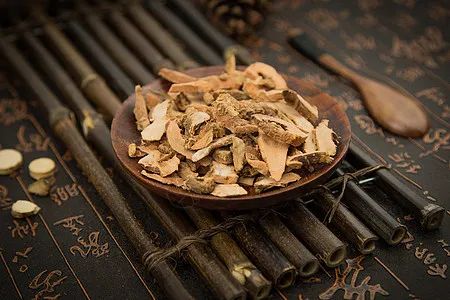 After one dose, vomiting ceased and the patient recovered.The mixed cold and heat formulas from the “Shang Han Lun” represent a significant innovation in the study of formulas by Zhang Zhongjing. Their scientific value is very high, and we should inherit and promote them well.The seven formulas discussed above, while all serving to harmonize yin and yang and resolve the evils of cold and heat, each have their own characteristics.For example, Ban Xia Xie Xin Tang harmonizes yin and yang with a focus on treating fullness; Gan Jiang, Huang Qin, Huang Lian, and Ren Shen Tang harmonize yin and yang with a focus on treating vomiting; Wu Mei Wan harmonizes yin and yang with a focus on treating roundworms; Ma Huang Sheng Ma Tang harmonizes yin and yang with a focus on inducing sweating; and Fu Zi Xie Xin Tang harmonizes yin and yang with a focus on supporting yang and stopping sweating.These all reflect the characteristic of TCM to treat according to the syndrome.Previous Articles:
After one dose, vomiting ceased and the patient recovered.The mixed cold and heat formulas from the “Shang Han Lun” represent a significant innovation in the study of formulas by Zhang Zhongjing. Their scientific value is very high, and we should inherit and promote them well.The seven formulas discussed above, while all serving to harmonize yin and yang and resolve the evils of cold and heat, each have their own characteristics.For example, Ban Xia Xie Xin Tang harmonizes yin and yang with a focus on treating fullness; Gan Jiang, Huang Qin, Huang Lian, and Ren Shen Tang harmonize yin and yang with a focus on treating vomiting; Wu Mei Wan harmonizes yin and yang with a focus on treating roundworms; Ma Huang Sheng Ma Tang harmonizes yin and yang with a focus on inducing sweating; and Fu Zi Xie Xin Tang harmonizes yin and yang with a focus on supporting yang and stopping sweating.These all reflect the characteristic of TCM to treat according to the syndrome.Previous Articles:
- Upper Body as a Furnace, Lower Body as an Ice Cellar! One Method to Open the Middle Jiao and Resolve Upper Heat and Lower Cold
-
Medical Sage Zhang Zhongjing’s Classic Formulas for Clearing Heat, Draining Fire, and Detoxifying, Treating Various Difficult and Complicated Diseases

